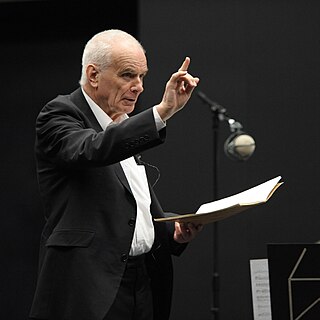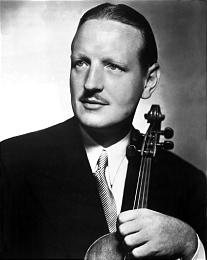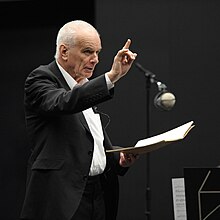
Sir Peter Maxwell Davies was an English composer and conductor, who in 2004 was made Master of the Queen's Music.
Symphony No. 3 was Aaron Copland's final symphony. It was written between 1944 and 1946, and its first performance took place on October 18, 1946 with the Boston Symphony Orchestra performing under Serge Koussevitzky. If the early Dance Symphony is included in the count, it is actually Copland's fourth symphony.
The Piano Concerto No. 3 in E major, Sz. 119, BB 127 of Béla Bartók is a musical composition for piano and orchestra. The work was composed in 1945 during the final months of his life, as a surprise birthday present for his second wife Ditta Pásztory-Bartók.

The Viola Concerto in A minor, Sz. 120, BB 128 was one of the last pieces written by Béla Bartók. He began composing his viola concerto while living in Saranac Lake, New York, in July 1945. The piece was commissioned by William Primrose, a respected violist who knew that Bartók could provide a challenging piece for him to perform. He said that Bartók should not "feel in any way proscribed by the apparent technical limitations of the instrument"; Bartók, though, was suffering from the terminal stages of leukemia when he began writing the viola concerto and left only sketches at the time of his death.

The Symphony No. 4 in A minor, Op. 63, is one of seven completed symphonies composed by Jean Sibelius. Written between 1910 and 1911, it was premiered in Helsinki on 3 April 1911 by the Philharmonia Society, with Sibelius conducting.
Requiem Canticles is a 15-minute composition by Igor Stravinsky, for contralto and bass soli, chorus, and orchestra. Stravinsky completed the work in 1966, and it received its first performance that same year.
The Symphony No. 1 Elevamini is an orchestral work by Australian-born composer Malcolm Williamson.

The Symphony No. 2 by Peter Maxwell Davies was commissioned by the Boston Symphony Orchestra in celebration of its centenary, and was composed in 1980. Seiji Ozawa conducted the world premiere with the BSO on 26 February 1981 at Symphony Hall, Boston.

The Symphony No. 6 by Peter Maxwell Davies was composed in Hoy during the first half of 1996, and was premiered on 22 June of the same year in the Phoenix Cinema, Kirkwall, as part of the twentieth St Magnus Festival, Orkney, by the Royal Philharmonic Orchestra conducted by the composer. The work was written with specific members of the RPO in mind, and is dedicated to the memory of the poet George Mackay Brown, who died on the day the symphony was completed.

The Symphony No. 3 by Peter Maxwell Davies was composed in 1984 on a commission from the BBC Philharmonic, who gave the world premiere on 19 February 1985, at the Free Trade Hall in Manchester, with Edward Downes conducting.

The Symphony No. 4 by Peter Maxwell Davies was commissioned for the Scottish Chamber Orchestra by Christian Salvesen plc and composed in 1989. It is dedicated to the memory of the violinist John Tunnell, who had been leader of the orchestra, and was premiered at the Royal Albert Hall on a BBC Promenade Concert on 10 September 1989, with the composer conducting the Scottish Chamber Orchestra.

The Symphony No. 1 by Peter Maxwell Davies was composed between 1973 and 1976, and is dedicated to Sir William Glock, "as a mark of friendship and of appreciation of his work for contemporary music in his years as music controller at the B.B.C.". It was commissioned by the Philharmonia Orchestra, which gave the premiere of the symphony at the Royal Festival Hall, London, on 2 February 1978, with Simon Rattle conducting.

The Symphony No. 7 by Peter Maxwell Davies was composed in 2000. It was written for and dedicated to the BBC Philharmonic Orchestra, by whom it was premiered on 19 June 2000 at the St Magnus Festival, in the Pickaquoy Centre, Kirkwall, Orkney, conducted by the composer.

The Symphony No. 8 is an orchestral composition by Peter Maxwell Davies, completed on 15 December 2001.

The Symphony No. 10, Op. 327, is a composition for orchestra, chorus, and baritone soloist, composed by Peter Maxwell Davies in 2013. It was premiered on 2 February 2014 at the Barbican Hall in London, by the London Symphony Orchestra and Chorus, with baritone soloist Markus Butter, conducted by Antonio Pappano.
The Percussion Concerto No. 2 is a concerto for solo percussion and orchestra by the Scottish composer James MacMillan. The work was jointly commissioned by the Netherlands Radio Philharmonic, the Philharmonia Orchestra, the Orchestre national du Capitole de Toulouse, the Cabrillo Festival of Contemporary Music, the Baltimore Symphony Orchestra, and the São Paulo State Symphony. It was first performed on November 7, 2014 at TivoliVredenburg in Utrecht, the Netherlands, by percussionist Colin Currie and the Netherlands Radio Philharmonic under conductor James Gaffigan. The composition is MacMillan's second percussion concerto after 1992's Veni, Veni, Emmanuel.
The Symphony No. 1 or Symphony: 'Vigil' is an orchestral symphony by the Scottish composer James MacMillan. It is the last of three interrelated compositions in MacMillan's Easter triptych Triduum commissioned by the London Symphony Orchestra. The piece was first performed at the Barbican Centre on 28 September 1997 by the London Symphony Orchestra under the conductor Mstislav Rostropovich.

The Concerto for Trumpet and Orchestra is a composition for trumpet solo and orchestra by the British composer Peter Maxwell Davies. The work was commissioned by the Philharmonia Orchestra for its then principal trumpeter John Wallace. It was given its world premiere by Wallace and the Philharmonia Orchestra under the conductor Giuseppe Sinopoli in Hiroshima on 21 September 1988.
The Cello Concerto No. 1 is a composition for solo cello and orchestra by the Finnish composer Magnus Lindberg. It was first performed in the Cité de la Musique, Paris on May 6, 1999 by the cellist Anssi Karttunen and the Orchestre de Paris under the direction of Esa-Pekka Salonen.





